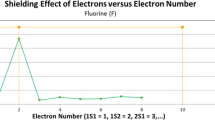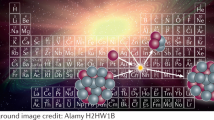Abstract
Mendeleev’s proposal of the periodic table was the final step in what happened to be a long series of attempts by leading chemists of the day to devise a “modern” system for the chemical elements and their compounds following on from Dalton’s notion of atoms in the early nineteenth century. While most of the early systems (including, finally, Mendeleev’s) were based on an ordering of the known elements by atomic weight, the (then) new concept of “valency” introduced by Frankland, Kekulé and others in the 1850s inspired many of the significant contributions (inter alia by Lothar Meyer) in the final decade before 1869. This chapter will begin with a summary of some key developments of chemical concepts during the first half of the nineteenth century and will emphasize the key role played by the Congress at Karlsruhe in 1860 and the way it shaped the development towards a periodic table of the chemical elements. We will then briefly recapitulate the role that “valency” played in the evolution towards a periodic table of the elements and how it has impacted the development of chemistry subsequently. The principal value of the valence concept is its role as an ordering principle for the elements, their compounds and their chemical structures. As chemists expanded the number of elements and their numerous compounds, it has become apparent that it also has significant limitations, and since its origins were based on a very limited view of chemical bonding and no structural information, it has had to adapt significantly during the last 150 years. Modern concepts generalizing structure formation and bonding capabilities of molecular fragments are generally based on qualitative frontier orbital models, which are guided by increasingly accurate quantum mechanical calculations. The difficulties encountered in the establishment of relationships between concepts of chemical bonding and quantum chemical modelling of the chemical bond are illustrated for metal–metal bond polarity in oligonuclear complexes at the end of the chapter.
Access this chapter
Tax calculation will be finalised at checkout
Purchases are for personal use only
Similar content being viewed by others
Notes
- 1.
Based on the “information” of prime matter (hyle) with a combination of the four elementary properties hot/cold, wet/dry [which in turn gave rise to the four elements fire, water, earth and air].
- 2.
For monoatomic hydrogen and oxygen, the result would have been 1 volume of water (H2O).
- 3.
In fact, Kekulé had approached both Wurtz and August W. Hofmann, then at the Royal College of Chemistry in London about the proposed meeting. Whereas Wurtz accepted with enthusiasm, Hofmann wrote back that “he was not one to fight in the vanguard and would not wish to place himself among the leaders of such a meeting”.
- 4.
Karlsruhe had also been the venue of a very successful meeting of the Deutsche Gesellschaft der Naturforscher und Ärzte 2 years before.
- 5.
Also spelt Karl Weltzien. Weltzien had been born in 1813 in St. Petersburg to ethnic German parents and was raised in Germany from the age of 10 onwards.
- 6.
Later the Technische Hochschule Karlsruhe and nowadays the Karlsruher Institut für Technologie (KIT).
- 7.
Dated “Paris, 5 April 1860”.
- 8.
- 9.
“.. was impressed by the clarity with which the piece treated the most important issues. It was as though the scales fell from my eyes, the doubts dissolved and made way for a feeling of calmest certainty…..”
- 10.
- 11.
The omission of graphical representations of the element spiral was due to the editor’s refusal to print them. Privately distributed separates of the scheme subsequent to the appearance of the articles failed to make a significant impact at the time and were only rediscovered later.
- 12.
See Table 5.5 in Ref. [5, p. 142].
- 13.
This term appeared in the first publication of his periodic system in Russian in 1869 but was not translated as such for a German version of this work which was the more widely read publication. This subsequently led to a dispute between Mendeleev and Meyer, who also began to use this term from 1870 onwards, about who had first published it. While the works of both protagonists in the development of a complete periodic table were clearly conducted independently, it appears that Mendeleev employed this terminology earlier than Meyer.
- 14.
It is based on the “central field approximation” for the potential energies of the electrons but, beyond that, is independent of the quantum chemical approximation employed.
- 15.
The reduction of the periodic table to quantum mechanical principles has been challenged inter alia by Scerri who pointed out, e.g. that the designation of electron configurations within the aufbau principle is based on a one-electron picture of the many electron systems which can only be justified by comparison with the experiment. However, as argued here, the specific pattern arising from the orbital description (and its role for the construction of the many particle wave functions) may be traced to the symmetry properties of the rotational group representing to a good approximation of the potential energies of the electrons experiencing the shielded Coulomb field of the nucleus.
- 16.
Coordination number = number of atoms bonded to the given atom.
References
deMilt C (1951). J Chem Educ 28:421
Ihde AJ (1961). J Chem Educ 38:83
Stock A (1933) Der Internationale Chemiker-Kongreß Karlsruhe 3.-5. September 1860 vor und hinter den Kulissen. Verlag Chemie, Berlin
Mendeleev D (1869). Z Chem 12:405
Scerri ER (2007) The periodic table – its story and significance. Oxford University Press, Oxford
Kekulé A (1861) Lehrbuch der organischen Chemie. Enke, Erlangen
Lavoisier AL (1789) Traité élémentaire de Chimie. Cuchet, Paris
Johnson DA, Williams AF (2019). Chimia 73:144
Proust JL (1807) J Phys 51:174
Proust JL (1807) J Phys 54:89
Proust JL (1807) J Phys 59:260, 321
Proust JL (1807) J Phys 63:364, 438
Dalton J (1808) A new system of chemical philosophy, part I. Bickerstaff, Manchester
Berzelius JJ (1845) Lehrbuch der Chemie, 5th edn, Arnold, Dresden. Berzelius introduced alphabetical element symbols from 1813 onwards: see Brock WH (1993) The Norton History of Chemistry
Avogadro A (1811). J Phys 73:58
Gay-Lussac LJ (1808). Mem de la Soc d’Arcueil 2:207
van Spronsen JW (1959). J Chem Educ 36:565
Döbereiner JW (1816). Ann Physik 56:332
Döbereiner JW (1816). Ann Physik 57:436
Döbereiner JW (1829). Ann Physik 15:301
Gmelin L (1974) Handbuch der Anorganischen Chemie, vol 1. 4th edn. Springer, Heidelberg, p 52
Frankland E (1852). Philos Trans R Soc 142:417
Laurent A (1854) Méthode de Chimie. Mallet-Bachelet, Paris
Kekulé A (1854). Ann Chem 90:309
Kekulé A (1857). Ann Chem 104:129
Kekulé A (1858). Ann Chem 106:129
Erlenmeyer F (1860). Z Chem 3:559
Erlenmeyer F (1864). Z Chem 7:628
Erlenmeyer F (1862). Z Chem 5:18
Meyer L (1864) Die Modernen Theorien der Chemie und ihre Bedeutung für die Chemische Statik. Maruschke & Behrendt, Breslau
Odling W (1855). Chem Soc Q J 7:1
Couper AS (1858). Philos Mag 16:104
deMilt C (1948). Chymia 1:153
Kuhn TS (1996) The structure of scientific revolutions3rd edn. University of Chicago Press, Chicago
Béguyer de Chancourtois AE (1862). C R Acad Sci 54:757, 840, 967
Newlands JAR (1863). Chem News 7:70
Newlands JAR (1865). Chem News 12:83
Odling W (1864). Q J Sci 1:642
Constable EC (2019). Dalton Trans (ahead of print)
Weeks ME (1932). J Chem Educ 9:1593
Seubert KZ (1895). Z Anorg Allg Chem 9:334
Weeks ME (1932). J Chem Educ 9:1605
Werner A (1905). Chem Ber 38:914
Werner A (1905) Neuere Anschauungen auf dem Gebiete der Anorganischen Chemie. Vieweg und Sohn, Brunswick
Bohr N (1913). Philos Mag 26:4
Sommerfeld A (1919) Neuere Anschauungen auf dem Gebiete der Anorganischen Chemie. Vieweg und Sohn, Brunswick
Kossel W (1916). Ann Phys 49:229
Lewis GN (1916). J Am Chem Soc 38:762
Lewis GN (1916). Proc Natl Acad Sci 2:588
Langmuir I (1919). J Am Chem Soc 41:868, 1543
Langmuir I (1919). Proc Natl Acad Sci 5:252
Mingos DMP (2019). Chimia 73:152
Mingos DMP (2016). Struct Bond 169:1
Heitler W, London F (1927). Z Phys 44:455
Pauling L (1939) The nature of the chemical bond and the structure of molecules and crystals. Cornell University Press, Ithaca
Pauling L (1932). J Am Chem Soc 54:3570
Mulliken RS (1934). J Chem Phys 2:782
Allred AL, Rochow EG (1958). J Inorg Nucl Chem 5:264
Allen LC (1989). J Am Chem Soc 111:9003
Mullay J (1987). Struct Bond 66:1
Coulson CA (1952) Valence. Oxford, London
Mulliken RS (1972) Spectroscopy, molecular orbitals, and chemical bonding. Nobel lectures, chemistry 1963–1970. Elsevier, Amsterdam
Hoffmann R (1982). Angew Chem Int Ed Engl 21:711
Mingos DMP, Wales DJ (1990) Introduction to cluster chemistry. Prentice Hall, Englewood Cliffs
Parkin G (2006). J Chem Educ 83:791
Grimm HG, Sommerfeld A (1926). Z Phys 36:36
Raub S, Jansen G (2001). Theor Chem Acc 106:223
Bader RFW (1994) Atoms in molecules: a quantum theory. Oxford University Press, Oxford
Bader RFW (1991). Chem Rev 91:893
Becke AD, Edgecombe KE (1990). J Chem Phys 92:5397
Savin A, Becke AD, Flad J, Nesper R, Preuss H, von Schnering HG (1991). Angew Chem Int Ed Engl 30:409
Silvi B, Savin A (1994). Nature 371:683
Savin A, Nesper R, Wengert S, Fässler TF (1997). Angew Chem Int Ed 36:1809
Werner H (2009) Landmarks in organo-transition metal chemistry: a personal view. Springer, New York
Ferguson GS, Wolczanski PT, Parkanyi L, Zonnevylle M (1988). Organometallics 7:1967
Jansen G, Schubart M, Findeis B, Gade LH, Scowen IJ, McPartlin M (1998). J Am Chem Soc 120:7239
Krapp A, Frenking G (2010). Theor Chem Acc 127:141
Takagi N, Krapp A, Frenking G (2011). Z Anorg Allg Chem 637:1728
Acknowledgements
LHG would like to thank H. Wadepohl for advice and helpful discussions.
Author information
Authors and Affiliations
Corresponding author
Editor information
Editors and Affiliations
Rights and permissions
Copyright information
© 2019 Springer Nature Switzerland AG
About this chapter
Cite this chapter
Gade, L.H. (2019). Chemical Valency: Its Impact on the Proposal of the Periodic System and Some Thoughts About Its Current Significance. In: Mingos, D. (eds) The Periodic Table I. Structure and Bonding, vol 181. Springer, Cham. https://doi.org/10.1007/430_2019_40
Download citation
DOI: https://doi.org/10.1007/430_2019_40
Published:
Publisher Name: Springer, Cham
Print ISBN: 978-3-030-40024-8
Online ISBN: 978-3-030-40025-5
eBook Packages: Chemistry and Materials ScienceChemistry and Material Science (R0)




